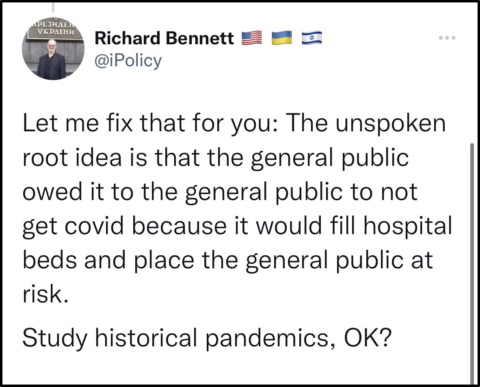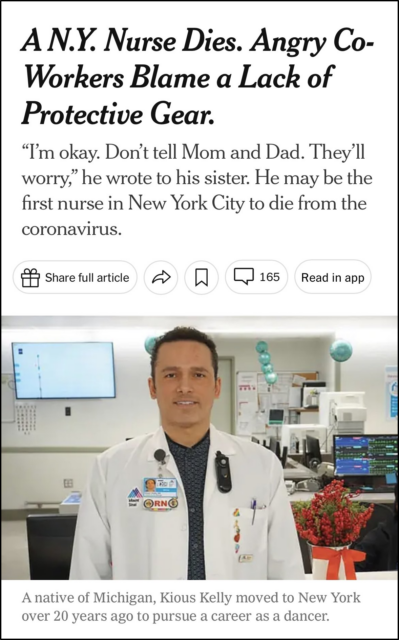“These deaths are a tragic loss”
The only surefire way to avoid dying of COVID is to avoid infection with SARS-CoV-2. One group of people that couldn’t avoid exposure was healthcare workers, who unsurprisingly had some of the highest death rates of any occupation, especially early in the pandemic. I knew several who died, as does anyone else who worked in a hospital at that time. According to one article from the World Health Organization:
Health and care workers are the foundation of health systems and the driving force to achieving universal health coverage and global health security. Their commitment and professionalism throughout the pandemic are evident to all: extraordinary people, performing extraordinary work.
However, too many of them have become infected, ill or died as a result of COVID-19.
WHO estimates that between 80,000 and 180,000 health and care workers could have died from COVID-19 in the period between January 2020 to May 2021, converging to a medium scenario of 115,500 deaths.
These deaths are a tragic loss. They are also an irreplaceable gap in the world’s pandemic response.
This is a surprisingly controversial statement. Not everyone agrees that “too many of them have become infected”.
“The unspoken root idea of his is that the general public owed it to doctors to not get COVID because it would place doctors at risk of getting COVID.”
With this in mind, let’s revisit a previous article in which I discussed Dr. Jay Bhattacharya’s “rebuttal” to my book, noting that it was nothing but straw man arguments. However, one of Dr. Bhattacharya’s pretend rebuttals deserves closer scrutiny. He wrote:
The unspoken root idea of his is that the general public owed it to doctors to not get COVID because it would place doctors at risk of getting COVID. Of course this is an inversion. Medical professionals serve the public, not the other way around.
I never said anything like this because such a statement would have been absurd, especially at the start of the pandemic. Unlike Dr. Bhattacharya, who made a YouTube video to discuss being called “fringe”, I know what hospitals were like during that first wave. We were bathed in SARS-CoV-2, often without adequate PPE. One article from April 2020 about Bellevue Hospital, where I work, correctly reported:
Nearly the entire hospital is one big COVID-19 unit, and even patients that aren’t in ICUs are extremely sick and often require intensive oversight.
Another 10,100, or 1,000 COVID patients would have overwhelmed our ability to care for them, but it wouldn’t have exposed us to more risk. Either Dr. Bhattacharya, who never treated a COVID patient himself, was ignorant of this sad reality or he can’t grasp the law of diminishing returns, a basic economic principle.
Unfortunately, this was not the first time Dr. Bhattacharya, who worked from his office this pandemic, claimed frontline healthcare workers were selfish and unethical. In a previous article, I discussed this quote of his:
If you think about medicine as a vocation, you’re supposed to devote your well-being to the life a patient that you are caring for…lockdowns actually reversed that and said look, ‘you the population should suffer so that my job in medicine can be easier‘, so a reversal of the norms of medicine where medicine serves people, not people serve medicine. The fact that medicine, especially the leaders of medicine were so strongly in favor of the lockdowns is a violation of the ethics of the medical profession. It essentially transforms the doctor-patient relationship to one where the patient serves the doctor rather than the other way around.
To summarize, Dr. Bhattacharya, who wisely dodged SARS-CoV-2 until after he was vaccinated, feels frontline healthcare workers who sought to slow the spread of the virus did so for two self-serving reasons: to lower their own “risk of getting COVID” and “so that my job in medicine can be easier”. Doctors who tried to stop the spread of COVID were violating medical ethics, according to a doctor who never saw anyone die from it.
“It’s not just about us, of course.”
Since Dr. Bhattacharya claims to have magically divined the “unspoken root idea” of my book without having read it, he’s unaware of what I actually wrote. Here’s what I wrote on this topic:
It’s obviously true that people who couldn’t stay home, like frontline healthcare workers, contracted COVID at a much higher rate than people who could isolate themselves. However, we wouldn’t have been better off had bankers contracted COVID during the first wave.
It’s not just about us, of course. Bus drivers wouldn’t have been better off if only more hedge fund managers contracted COVID in April 2020. Had the laptop class been infected all at the same time then, the catastrophe that befell us in New York City and elsewhere would have been much worse. Hospitals were deluged as it was and no one working in one bemoaned the fact that lockdowns protected the laptop class. We wanted everyone to be safe and would have been furious had we learned of young lawyers partying inside while mass death surrounded us. Even if they all turned out fine, we knew their infections would spill over into vulnerable people.
Indeed, a CDC report published in October 2020, just two days before Dr. Bhattacharya unleashed his disastrous plan to achieve herd immunity in 3-6 months through the mass infection of 250 million unvaccinated Americans found:
During June–August 2020, COVID-19 incidence was highest in persons aged 20–29 years, who accounted for >20% of all confirmed cases. Younger adults likely contribute to community transmission of COVID-19. Across the southern United States in June 2020, increases in percentage of positive SARS-CoV-2 test results among adults aged 20–39 years preceded increases among those aged ≥60 years by 4–15 days.
A more recent study of nearly 850,000 American households, found that 70% of COVID transmissions started with a child.
As a reminder, over 800 New Yorkers died of COVID on a single day during the pandemic’s peak in April 2020, and giant refrigerated trucks were needed throughout the city to store the corpses. Frontline healthcare workers who sought to limit COVID at that time weren’t reversing the doctor-patient relationship, nor were they violating the ethics of the medical profession. They were trying to prevent death and suffering. It’s that simple.
However, our attempts to stop the virus interfered with Dr. Bhattacharya’s stated mission to have the population “build up immunity to the virus through natural infection”. As a result, we are his targets, and he must reframe our efforts to stop a deadly virus as an unethical combination of laziness and cowardice. Even though frontline healthcare workers have been threatened and attacked this pandemic, Dr. Bhattacharya vilifies us, not for the care we directly provided to COVID patients, but for nearly anything we did to try to limit the number of COVID patients.
Remember, they wanted them infected.
“The general public owed it to the general public to not get COVID.”
In the real world, viruses can go viral and hospitals can be overwhelmed. For this reason, the general public owed it to the general public to not get COVID, an obvious point that eluded Dr. Bhattacharya.

However, let’s indulge Dr. Bhattacharya’s absurd fantasy and imagine a fictional world where healthcare workers asked the public to avoid bars and parties only so they wouldn’t die of COVID. Would that have been inappropriate? Are our lives, and the lives of the people we live with, totally expendable? Are sick and dead healthcare workers good for the public during a raging pandemic?
Dr. Bhattacharya is right that healthcare workers serve the public, namely the patients directly under our care. We knew when we signed up that we might be exposed to deadly pathogens, and millions of healthcare workers around the world chose to work with COVID patients, risking injury and death to honor the ethics of our profession. However, we are also part of the public, and our lives have value too. Too many frontline healthcare workers died this pandemic, none of whom volunteered to be cannon fodder to fulfill Dr. Bhattacharya’s failed dream of herd immunity through the mass infection, even though our health was a sacrifice he seemed willing to make.


